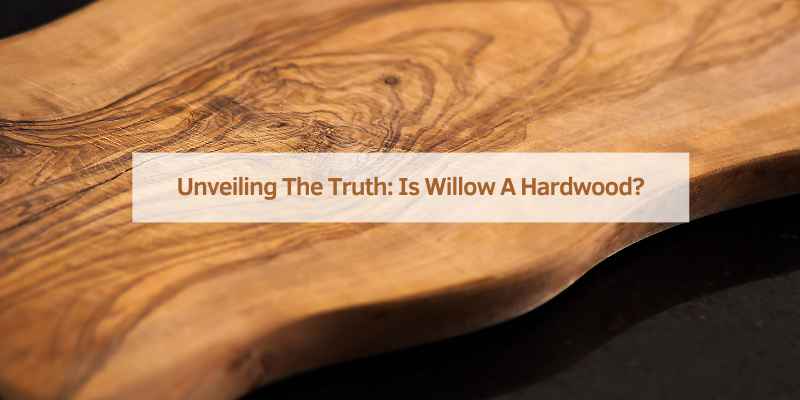Yes, Willow is classified as a hardwood due to its density and strength, making it ideal for furniture and construction. Willow wood comes from the Willow tree, a deciduous tree known for its slender and flexible branches.
The wood is commonly used in crafting furniture, baskets, and cricket bats. With its light color and smooth texture, Willow wood is easy to work with and finishes well. Apart from its aesthetic appeal, Willow wood is also valued for its durability and resistance to decay.
As a hardwood, Willow provides a versatile and sustainable option for various woodworking projects.
Introduction To Willow Wood
Willow wood is a popular material known for its unique properties and versatile uses. In this section, we will explore the basics of willow wood and how it compares to other hardwoods and softwoods.
The Basics Of Willow
Willow wood is derived from the willow tree, which is known for its slender and flexible branches. It is a deciduous hardwood that belongs to the Salicaceae family. Willow wood is valued for its lightweight nature, making it ideal for various woodworking and crafting applications.
Comparing Hardwoods And Softwoods
When comparing hardwoods and softwoods, it’s important to note that the distinction between the two is not based on the wood’s actual hardness. Hardwoods, such as willow, typically come from deciduous trees and have a more complex structure, while softwoods come from coniferous trees and have a simpler cell structure..

The Nature Of Willow Trees
Species And Varieties
Willow trees belong to the Salicaceae family and are known for their graceful, pendulous branches and narrow leaves. The most common species include the white willow, black willow, and crack willow, each with its own unique characteristics and uses.
Geographical Spread
Willow trees are found in various regions across the Northern Hemisphere, thriving in moist soils near rivers, streams, and wetlands. They are particularly abundant in Europe, Asia, and North America, where their resilient nature allows them to flourish in diverse climates.
Characteristics Of Willow Wood
Willow wood is known for its unique features and uses in various applications. Let’s explore the physical properties, durability, and usability of willow wood.
Physical Properties
Willow wood is lightweight, making it easy to work with and ideal for crafting projects.
It has a light brown color with a smooth texture, adding a natural aesthetic appeal.
Durability And Usability
Willow wood is moderately durable but may not be as long-lasting as other hardwoods.
It is commonly used in making furniture, baskets, and musical instruments.
Classification Of Hardwood And Softwood
Before diving into whether Willow is a hardwood or not, let’s first understand the classification of hardwood and softwood. Contrary to popular belief, hardwood and softwood are not classified based on their hardness or softness. Instead, they are classified based on their botanical criteria.
Botanical Criteria
The botanical criteria for classifying hardwood and softwood is based on the structure of the tree’s seeds. Hardwoods come from trees that have enclosed seeds, such as oak, cherry, and walnut. On the other hand, softwoods come from trees that have exposed seeds, such as pine, spruce, and cedar.
Common Misconceptions
One common misconception about hardwood and softwood is that hardwood is always harder than softwood. However, this is not always the case. For example, balsa, which is a type of hardwood, is actually softer than many types of softwood.
Another misconception is that softwood is less durable than hardwood. While hardwood is generally more dense and durable, there are some types of softwood, such as redwood and cedar, that are highly resistant to decay and rot.
So, is Willow a hardwood? The answer is no. Willow comes from a tree that has exposed seeds, which classifies it as a softwood.
Willow’s Place In The Hardwood-softwood Spectrum
When it comes to categorizing trees, the terms ‘hardwood’ and ‘softwood’ are often used. However, the classification is not as straightforward as the names suggest. While hardwoods are typically known for their hardness and strength, and softwoods are known for their softer and more pliable nature, the names don’t always reflect the actual properties of the trees. Willow, for instance, is often considered a hardwood, but is it really?
Scientific Perspective
From a scientific perspective, the classification of hardwoods and softwoods is based on the tree’s reproduction method, rather than the actual hardness of the wood. Hardwoods come from deciduous trees that lose their leaves in the fall, while softwoods come from evergreen trees that retain their leaves year-round. This means that willow, which is a deciduous tree, is technically classified as a hardwood.
Practical Implications
From a practical standpoint, the classification of willow as a hardwood or softwood has important implications. Hardwoods are typically used for furniture, flooring, and other high-end applications that require strength and durability. Softwoods, on the other hand, are often used for construction, paper products, and other applications where a softer, more pliable wood is needed. However, willow is a unique case because it has some of the characteristics of both hardwoods and softwoods. While it is relatively pliable and easy to work with, it is also strong and durable, making it a popular choice for furniture and other applications.
So, while willow is technically classified as a hardwood, its unique properties make it a versatile and valuable wood that can be used in a variety of applications.
Uses Of Willow Wood
Willow wood, although classified as a hardwood, is commonly used for making baskets, furniture, and even musical instruments. Its pliability and durability make it a versatile material for various applications.
Traditional Applications
Willow wood has been used for various traditional applications for centuries. Its versatility and flexibility make it ideal for a wide range of purposes. Here are some of the traditional uses of willow wood:
- Basket Weaving: Willow wood’s pliable nature makes it a popular choice for creating baskets of different shapes and sizes.
- Furniture Making: The strength and durability of willow wood have made it a reliable material for crafting furniture pieces such as chairs, tables, and cabinets.
- Tool Handles: Willow wood’s resilience and shock-absorbing properties make it suitable for tool handles, providing a comfortable grip and reducing strain during use.
- Fencing and Hurdles: Willow wood’s natural strength and flexibility make it a popular choice for constructing fences and hurdles, both for decorative and functional purposes.
- Charcoal Production: Willow wood is often used in the production of charcoal due to its high carbon content and low ash content.
Modern Innovations
In addition to its traditional uses, willow wood has found new applications in modern times. Here are some innovative uses of willow wood:
- Environmental Restoration: Willow wood is commonly used in environmental restoration projects to stabilize soil, control erosion, and enhance water quality due to its extensive root system.
- Biodegradable Packaging: The eco-friendly properties of willow wood make it an attractive option for producing biodegradable packaging materials, reducing the environmental impact of traditional plastic packaging.
- Art and Crafts: Willow wood’s aesthetic appeal and ease of manipulation have made it a favorite material for artists and craftsmen, who create sculptures, decorative items, and intricate designs using this versatile wood.
- Alternative Medicine: Willow wood extracts have been used in alternative medicine for their potential anti-inflammatory and pain-relieving properties, particularly in the form of natural remedies such as teas and tinctures.
- Energy Generation: Willow wood is being explored as a sustainable source of biomass energy, as it grows rapidly and can be harvested for fuel production.
Environmental Impact Of Harvesting Willow
Willow is a versatile material used in various industries. Its harvesting can have environmental implications.
Sustainability Practices
- Use of eco-friendly harvesting methods.
- Minimizing waste and promoting recycling.
- Ensuring replanting of willow trees for future generations.
Willow As A Renewable Resource
Willow trees grow rapidly, making them a sustainable resource.
- Low impact on the environment.
- Quick regeneration after harvesting.
- Minimal carbon footprint compared to other hardwoods.
Unveiling The Truth: Is Willow A Hardwood?
Willow trees are often associated with their use in cricket bats, but are they actually a hardwood? Despite their common usage in sports equipment, willow trees are considered a softwood due to their porous and lightweight nature.
Final Verdict
After exploring the characteristics of willow, it’s clear that it falls under the category of hardwood.
Implications For Consumers And Industry
Consumers seeking durable, sustainable materials can consider willow products. In the industry, the usage of willow can lead to innovative environmentally-friendly solutions.

Frequently Asked Questions
Is Willow Considered A Hardwood?
Yes, willow is technically a hardwood, but it is softer than other hardwoods such as oak or maple. It falls under the category of “soft hardwoods” due to its relatively low density and hardness.
What Are The Characteristics Of Willow Wood?
Willow wood is known for its light weight, straight grain, and smooth texture. It is also relatively flexible and resistant to splitting, making it suitable for crafting furniture, baskets, and cricket bats.
Is Willow Wood Durable For Furniture?
While willow wood is not as hard as some other hardwoods, it is still durable and suitable for crafting furniture. With proper care and maintenance, furniture made from willow wood can last for many years, especially when used indoors.
Conclusion
Willow is indeed considered a hardwood, despite its softer nature compared to other hardwood species. It possesses unique qualities that make it suitable for various applications, such as furniture, flooring, and crafts. Its flexibility, light weight, and beautiful grain patterns make it an appealing choice for many.
Whether you’re looking for a durable or decorative wood, Willow can certainly be a viable option.


